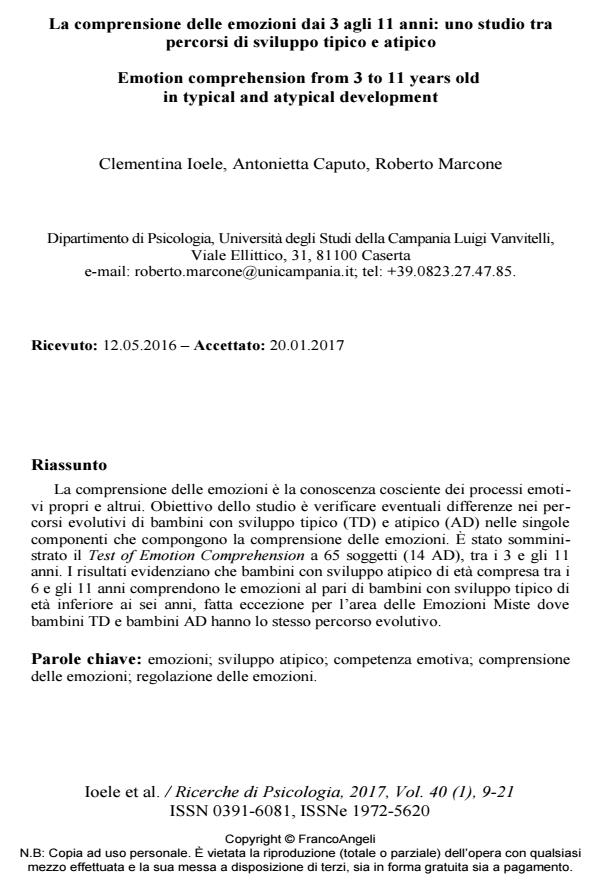La comprensione delle emozioni dai 3 agli 11 anni: uno studio tra percorsi di sviluppo tipico e atipico
Titolo Rivista RICERCHE DI PSICOLOGIA
Autori/Curatori Clementina Ioele, Antonietta Caputo, Roberto Marcone
Anno di pubblicazione 2017 Fascicolo 2017/1 Lingua Italiano
Numero pagine 13 P. 9-21 Dimensione file 217 KB
DOI 10.3280/RIP2017-001001
Il DOI è il codice a barre della proprietà intellettuale: per saperne di più
clicca qui
Qui sotto puoi vedere in anteprima la prima pagina di questo articolo.
Se questo articolo ti interessa, lo puoi acquistare (e scaricare in formato pdf) seguendo le facili indicazioni per acquistare il download credit. Acquista Download Credits per scaricare questo Articolo in formato PDF

FrancoAngeli è membro della Publishers International Linking Association, Inc (PILA)associazione indipendente e non profit per facilitare (attraverso i servizi tecnologici implementati da CrossRef.org) l’accesso degli studiosi ai contenuti digitali nelle pubblicazioni professionali e scientifiche
La comprensione delle emozioni è la conoscenza cosciente dei processi emotivi propri e altrui. Obiettivo dello studio è verificare eventuali differenze nei percorsi evolutivi di bambini con sviluppo tipico (TD) e atipico (AD) nelle singole componenti che compongono la comprensione delle emozioni. È stato somministrato il Test of Emotion Comprehension a 65 soggetti (14 AD), tra i 3 e gli 11 anni. I risultati evidenziano che bambini con sviluppo atipico di età compresa tra i 6 e gli 11 anni comprendono le emozioni al pari di bambini con sviluppo tipico di età inferiore ai sei anni, fatta eccezione per l’area delle Emozioni Miste dove bambini TD e bambini AD hanno lo stesso percorso evolutivo.;
Keywords:Emozioni; sviluppo atipico; competenza emotiva; comprensione delle emozioni; regolazione delle emozioni.
- Albanese, O., & Molina, P. (2008). Lo sviluppo della comprensione delle emozioni e la sua valutazione. Milano: Unicopli.
- Altshuler, J., & Rubble, D. (1989). Developmental Changes in Children’s Awareness of Strategies for Coping with Uncontrollable Stress. Child Development, 60, 1337-1349. DOI: 10.2307/1130925
- Band, E., & Weisz, J. (1988). How to Feel Better When It Feels Bad: Children’s Perspectives on Coping with Everyday Stress. Developmental Psychology, 24, 247-253. DOI: 10.1037/0012-1649.24.2.247
- Bullock, M., & Russell, J.A. (1985). Further Evidence on Preschoolers’ Interpretation of Facial Expressions. International Journal of Behavioral Development, 8, 15-38. DOI: 10.1177/016502548500800103
- Cutting, A.L., & Dunn, J. (1999). Theory of Mind, Emotion Understading, Language, and Family Background: Individual Differences and Interrelations. Child Development, 70, 853-865. DOI: 10.1111/1467-8624.00061
- De Rosnay, M., & Harris, P.L. (2002). Individual Differences in Children’s Understanding of Emotion: The Role of Attachment and Language. Attachment and Human Development, 4, 39-45. DOI: 10.1080/14616730210123139
- Denham, S.A. (1986). Social Cognition, Prosocial Behavior, and Emotion in Preschoolers: Contextual Validation. Child Development, 57, 194-201. DOI: 10.2307/1130651
- Denham, S.A. (1998). Emotional Development in Young Children. New York: The Guilford Press. (Tr.it.: Lo sviluppo emotivo nei bambini. Roma: Astrolabio, 2001).
- Gordon, S.L. (1989). The Socialization of Children’s Emotions: Emotional Culture, Competence and Exposure. In C. Saarni & P.L. Harris (Eds.), Children’s Understanding of Emotion (pp. 310-349). Cambridge: England University Press.
- Harris, P.L., Donnelly, K., Guz, G., & Pitt-Watson, R. (1986). Children’s Understanding of the Distinction Between Real and Apparent Emotion. Child Development, 57, 895-909. DOI: 10.2307/1130366
- Harris, P.L. (1989). Children and Emotion. Oxford: Blackwell. (Tr.it.: Il bambino e le emozioni. Milano: Cortina, 1991).
- Harris, P.L., Johnson, C., Hutton, D., Andrews, G., & Cooke, T. (1989). Young Children’s Theory of Mind and Emotion. Cognition and Emotion, 3, 379-400. DOI: 10.1080/02699938908412713
- Harris, P.L., & Lipian, M. (1989). Understanding Emotion and Experiencing Emotion. In C. Saarni & P. Harris (Eds.), Children’s Understanding of Emotion (pp. 241-258). New York: Cambridge University Press.
- Harter, S., & Buddin, B. (1987). Children’s Understanding of the Simultaneity of Two Emotions: A Five-stage Acquisition Sequence. Developmental Psychology, 23, 388-399. DOI: 10.1037/0012-1649.23.3.388
- Harter, S., & Whitesell, N. (1989). Developmental Changes in Children’s Emotion Concepts. In C. Saarni & P.L. Harris (Eds.), Children’s Understanding of Emotions (pp. 81-116). New York: Cambridge University Press.
- Hollingshead, A.B. (1975). Four factor index of social status. Unpublished Manuscript. Yale University, New Haven.
- Meerum Terwogt, M., & Stegge, H. (1995). Children’s Understanding of the Strategic Control of Negative Emotions. In J. Russell, J.-M. Fernandez-Dols & A. Manstead (Eds.), Everyday Conceptions of Emotions (pp. 373-390). Dordrecht: Kluwer.
- Pons, F., & Harris, P. (2000). Test of Emotion Comprehension-TEC, Oxford: Oxford University Press.
- Pons, F., Lawson, J., Harris, P.L., & de Rosnay, M. (2003). Individual Differences in Children’s Emotion Understanding: Effects of Age and Language. Scandinavian Journal of Psychology, 44, 347-353. DOI: 10.1111/1467-9450.00354
- Pons, F., Harris, P.L., & de Rosnay, M. (2004). Emotion Comprehension Between 3 and 11 Years: Developmental Period and Hierarchial Organization. European Journal of Developmental Psychology, 127-152. DOI: 10.1080/17405620344000022
- Raven, J.C. (1947) Coloured Progressive Matrices, Sets A, Ab, B. Oxford: Oxford Psychologists.
- Saarni, C. (2000). Emotional Competence a Developmental Perspective. In R. Baron, J.D.A. Parker & J.D. Mayer (Eds.), The Handbook of Emotional Intelligence (pp. 68-91). San Francisco: Jossey-Bass.
- Southam-Gerow, M., & Kendall, P.C. (2002). Emotion Regulation and Understanding: Implications for Child Psychopathology and Therapy. Clinical Psychology Review, 22, 189-222. DOI: 10.1016/S0272-7358(01)00087-3
- Venuti, P., & Senese, V.P. (2007). Un questionario di autovalutazione degli stili parentali: uno studio su un campione italiano [A self-assessment questionnaire of parental styles: a study on an Italian sample]. Giornale Italiano di Psicologia [Italian Journal of Psychology], 34(3), 677-698. DOI: 10.1421/25224
- Assessing the Factor Structure and Measurement Invariance of the Test of Emotion Comprehension (TEC): A Large Cross-Sectional Study with Children Aged 3-10 Years Valeria Cavioni, Ilaria Grazzani, Veronica Ornaghi, Alessandro Pepe, Francisco Pons, in Journal of Cognition and Development /2020 pp.406
DOI: 10.1080/15248372.2020.1741365
Clementina Ioele, Antonietta Caputo, Roberto Marcone, La comprensione delle emozioni dai 3 agli 11 anni: uno studio tra percorsi di sviluppo tipico e atipico in "RICERCHE DI PSICOLOGIA " 1/2017, pp 9-21, DOI: 10.3280/RIP2017-001001